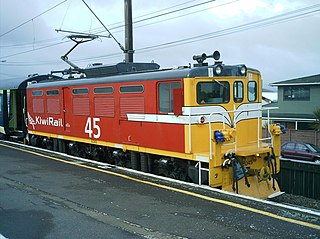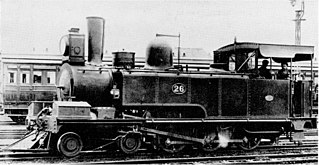
The Weka Pass Railway is a New Zealand heritage railway based in Waipara, North Canterbury. It is operated on a 12.8 km length of the former Waiau Branch railway between Waipara and Waikari. The railway is operated by an incorporated society whose members come from all walks of life and are largely resident in the city of Christchurch, 60 km to the south. The railway began carrying passengers in 1984 and is now well established locally and nationally.

The Ocean Beach Railway (OBR) is a heritage railway that operates in Dunedin, New Zealand. It is located between John Wilson Drive in the suburb of Saint Kilda and sports grounds near Forbury Park Raceway, and runs parallel with the city's main beach, Ocean Beach. This is near where the Ocean Beach Branch once ran, but not on the same formation.

The Plains Vintage Railway & Historical Museum is a heritage railway and recreated historic village in the Tinwald Domain, Tinwald, New Zealand. The railway runs on approximately three kilometres of rural railway line that was once part of the Mount Somers Branch. The village and railway are open regularly to the public. The railway utilises preserved and restored locomotives and rolling stock once used on New Zealand's national railway network, while the village shows visitors how life was lived in New Zealand's pioneering past.

The New Zealand DF class locomotive of 1954 was the first class of mainline diesel-electric locomotives built for New Zealand's national railway network, built by English Electric. It should not be confused with General Motors Electro-Motive Division DF class of 1979.
Steam Incorporated, often abbreviated to Steam Inc., is a railway heritage and preservation society based at the Paekakariki railway station, Paekakariki at the southern end of the Kapiti Coast, approximately 50 minutes north of Wellington on the west coast of New Zealand's North Island. Unlike some societies who operate on preserved sections of closed branch lines, Steam Incorporated own a depot beside one of the country's most important railway lines, the North Island Main Trunk railway, and restores heritage locomotives and rolling stock for use on excursions on the regular national rail network.

The New Zealand EA class of electric locomotives were used on the New Zealand rail network between 1968 and 1997 on the Otira – Arthur's Pass section of the Midland line in the South Island, through the Otira Tunnel. Following reconditioning, three were used by KiwiRail's Tranz Metro in Wellington from 2008 to 2011 to top and tail Metlink suburban passenger trains as an interim measure before new rolling stock arrived. Four of the five locomotives were scrapped in 2013 with one being set aside for preservation.
The rolling stock used on the Isle of Man Railway today is entirely original but the serviceable passenger coaches number 14, out of an original total of 75 carriages. The 3 ft gauge railway was provided with a variety of stock from different manufacturers over its time, and types of coach were categorised according to a lettering system, with the original four-wheeled coaches being of A, B, C and D types, and so on. The F prefix encompassed all bogie vehicles including conversions from the A-D series. Letters G-M denoted goods stock. N referred to ex-Manx Northern Railway 6 wheel carriages. The types of stock can be summarised as follows:-
The Victorian Railways used a variety of railway wagons for the transport of livestock.
As the Victorian Railways' fleet of Z vans began to age, the railways decided to invest in bogie designs for vans. Some van designs were included in a class of new passenger vehicles. Many other vans, for both freight and passenger work, were built separately from any other rolling stock developments, and these are the ones that feature here in detail.
The Victorian Railways used a variety of both 4-wheel and bogie open wagons for the transport of a wide range of loads.

The South African Railways Class 8X 2-8-0 of 1901 was a steam locomotive from the pre-Union era in the Cape of Good Hope.

The South African Railways Class 8 4-8-0 of 1902 was a steam locomotive from the pre-Union era in the Cape of Good Hope.

The South African Railways Class 8F 4-8-0 of 1904 was a steam locomotive from the pre-Union era in the Cape of Good Hope.

The South African Railways Class 3 4-8-2 of 1909 was a steam locomotive from the pre-Union era in the Colony of Natal.

The South African Railways Class C 4-6-0T of 1879 was a steam locomotive from the pre-Union era in the Colony of Natal.

The South African Railways Class MF 2-6-6-2 of 1911 was a steam locomotive from the pre-Union era in Transvaal.
The Victorian Railways used a variety of boxcars or covered goods wagons for the transport of all manner of goods. This page covers the history and development of the various classes, and how they changed through their lives.
The South African Railways Class 8R 4-8-0 of 1930 was a steam locomotive.
The Victorian Railways used a variety of flat wagons for the transport of a wide range of loads. Generally speaking, the bogie wagons were custom-built for the job, while the fixed-wheel variants were cut down from former open wagons. Loadings would be placed on the deck and, if necessary, protected with tarps, then secured to the wagons with chains or rope connecting to lashing rings along the side of the wagon frames.

Tangiwai was a station on the North Island Main Trunk line, in the Ruapehu District of New Zealand. The station served the settlement of Tangiwai. The nearby pulp and saw mills are now one of the main sources of freight on NIMT. In 1953 the Tangiwai disaster occurred when the nearby bridge over the Whangaehu River was swept away.












